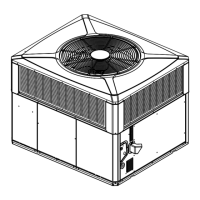18-BG07D1-1B-EN
27
Heating Shut-Down
Set the comfort control to OFF or adjust the heating set
point to belowroom temperature.
Sequence of Operation
The following description applies to the *CONT402.
Some of the operational differences of the *CONT802
and *CONT803 are described at the end of this section.
The following description applies to non-restricted
mode. Restricted operation will be identical except that
transitions from and to second stage (heat pump)
heating to and from third stage (gas) heating can occur,
not necessarily as a result of building load and
equipment capacity, but as determined by the outdoor
temperature changeover point selected by the installer
at the indoor thermostat (see RESTRICTED MODE
described on page 23).
CCaallll ffoorr 11sstt ssttaaggee hheeaattiinngg ((hheeaatt ppuummpp))::
With the room thermostat set to HHEEAATT and the fan set
to AAUUTTOO, NO power is supplied from the room
thermostate "O" terminal to the unit switchover valve
coil (SOV) and the "O" terminal on the ECMC board.
This leaves the switch-over valve (SOV) in the normal
position for heating and is the signal for the (ECMC) to
run at indoor fan speeds designed for heating. On a call
for heating, power is supplied to the unit from the
room thermostat (Y1) and (G) terminal. (Y1) provides
power to the compressor contactor (CC), the defrost
control (DFC) and the electronically commutated motor
control (ECMC). (G) provides power to the (ECMC) for
low speed (ECM) indoor fan motor operation.
The energized compressor contactor (CC) completes
the circuit to the compressor for 1st stage (Low)
operation and the outdoor single speed fan motor
(ODM). The indoor fan motor (ECM) will operate on low
speed. The room thermostat will continue to cycle the
compressor and fans to maintain the desired
temperature.
CCaallll ffoorr 22nndd ssttaaggee aafftteerr 11sstt ssttaaggee ((hheeaatt ppuummpp))::
On a call for 2nd stage heating, power is supplied from
the room thermostate (Y2) terminal to the compressor
rectifier (ACR) and the (ECMC). This energizes the
(ACR) switching the compressor to 2nd stage (High)
operation. The room thermostat will continue to cycle
the system between 1st and 2nd stage to maintain the
desired temperature.
CCaallll ffoorr ggaass hheeaattiinngg aafftteerr 22nndd ssttaaggee ((hheeaatt ppuummpp))::
If the heat pump capacity is not enough to handle the
building load, the heat pump is turned off and the gas
heat is brought on. The thermostat will call for low fire
1st stage gas heat by removing power from (Y/Y1) and
by powering (W1). (G) will remain energized for a
minimum of 2 minutes so that the transition to gas heat
will not interrupt indoor airflow.
(W1) from the thermostat signals the control module
(IGN) to run its self-check routine. After the control
module has verified that the pressure switch (PS)
contacts are open, the limit switch (TCO) contacts are
closed, and the flame rollout (RO) switch is closed, the
induced draft blower (CFM) will be energized on high
speed for approximately 5 seconds.
After the induced draft blower (CFM) has come up to
speed, the control will verify that the pressure switch
(PS) contacts are closed and will switch the induced
draft blower to low speed for a 20 second prepurge.
The gas valve (GV) is energized in the first stage to
permit gas flow and the spark igniter (IP) is energized.
The flame detector (FD) confirms that ignition has been
achieved within the 7 second trial period.
When the flame detector confirms that ignition has
been achieved, the delay to indoor blower ON period
begins timing. After approximately 45 seconds, the
control module (IGN) will take over control of the
indoor blower motor (IDM). The control module (IGN)
will command the indoor blower to operate at low
speed throughout the heating cycle.
To maintain the indoor temperature at the desired
setpoint, the thermostat may operate the low fire gas
heating continuously or cycle low fire gas heating off
and on (cycling on 2nd stage heat).
CCyycclliinngg oonn llooww ffiirree ggaass hheeaatt:: When the thermostat
cycles off during low fire first stage gas heating, power
will be removed from (W1), the gas valve (GV) will
close, and the flame will extinguish. The induced draft
blower (CFM) will continue to run for a postpurge
period of approximately 5 seconds before shutting off.
The indoor blower motor (IDM) will continue to operate
as the heat exchanger cools down (the delay is field
selectable for 45 or 90 seconds) before being turned off
by the control module.
NNootteess::
• During gas heating operation, the indoor
blower is controlled by the normal sequence
of gas furnace operation, and not by the
thermostat.
• The *CONT402 may transition from gas
heating to heat pump heating and then back
to gas heating instead of just cycling the gas
heat on and off if the building load is
relatively low (see the Transitioning from
low fire gas heating to heat pump operation
for a complete description).
CCaallll ffoorr hhiigghh ffiirree 22nndd ssttaaggee ggaass hheeaattiinngg aafftteerr llooww
ffiirree::
The thermostat adds (W2/X2) to (W1) signaling a call
for second stage gas heat. The induced draft motor
(CFM) is energized on high speed and the gas valve
(GV) on second stage. After approximately 30 seconds
the control energizes the indoor blower on high speed.
To maintain the indoor temperature at the desired
setpoint, the thermostat may operate the high fire gas
UUnniitt SSttaarrttuupp

